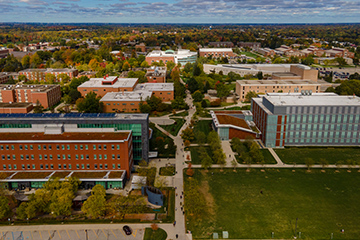Mapping a crisis
The shifting landscape of opioid deaths
The opioid epidemic in the United States isn’t standing still, and neither are the researchers working to understand it. Central Michigan University President Neil MacKinnon and research collaborator and College of Medicine faculty member Preshit Ambade are using advanced geospatial analysis to trace how the crisis has evolved over the last 15 years.
Their recently published study shows a shifting map of opioid-related deaths, revealing not only where the epidemic has spread, but how the drugs themselves have changed. Beginning with prescription painkillers, progressing to heroin, and now centered on potent synthetics like fentanyl, the issue continues to grow more complex and deadly.
“This isn’t a one-size-fits-all crisis,” MacKinnon said. “It’s moving, adapting, and hitting different communities in different ways.” That’s why one of the research team’s primary goals is to help policymakers tailor local solutions instead of relying on broad national approaches.
Their findings show the epidemic has gradually migrated east, with each region facing unique challenges. In rural areas, mobile health clinics and naloxone distribution points may be essential. In urban centers, mental health resources could be the key.
Ambade notes how rapidly the landscape keeps changing. “Analytically, we achieved our short-term goal,” he said, “but the epidemic continues to evolve.”
MacKinnon and Ambade worked on this project prior to coming to CMU. They collaborated with Dr. Diego Cudros and Santiago Escobar, whose analytical support was instrumental in shaping the study.
Now at CMU, MacKinnon and Ambade are focused on applying their findings here in Michigan, where alarming data show that nearly the entire state falls within a cluster of elevated opioid-related mortality rate.
Their research is already shaping how the state of Michigan is responding. One major effort on the horizon is the 2025 Opioid Summit. The statewide event will bring together health professionals, legal experts, educators, and community leaders to share solutions and strengthen efforts to combat this public health emergency.
Even as he leads the university, MacKinnon remains deeply committed to research and collaboration. “If you're a CMU student and this study interests you, feel free to send me an email,” he said. “This university’s strong research culture is the perfect environment for tackling urgent public health challenges.”
Looking ahead, the team plans to explore how the COVID-19 pandemic has influenced drug supply chains and usage patterns. Their work delivers a clear message: solving the opioid crisis demands flexible, community-specific solutions, and the fight is far from over.




